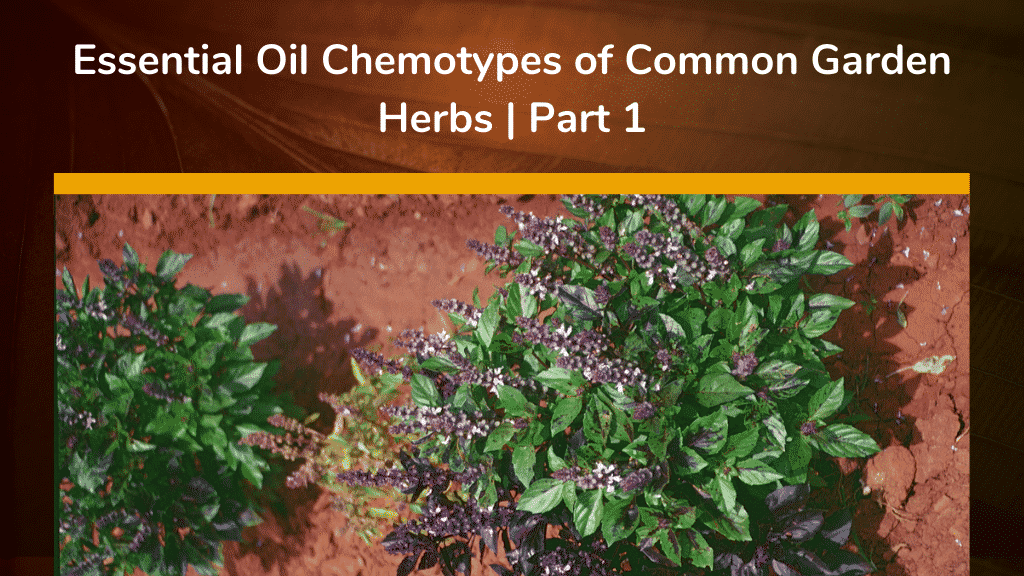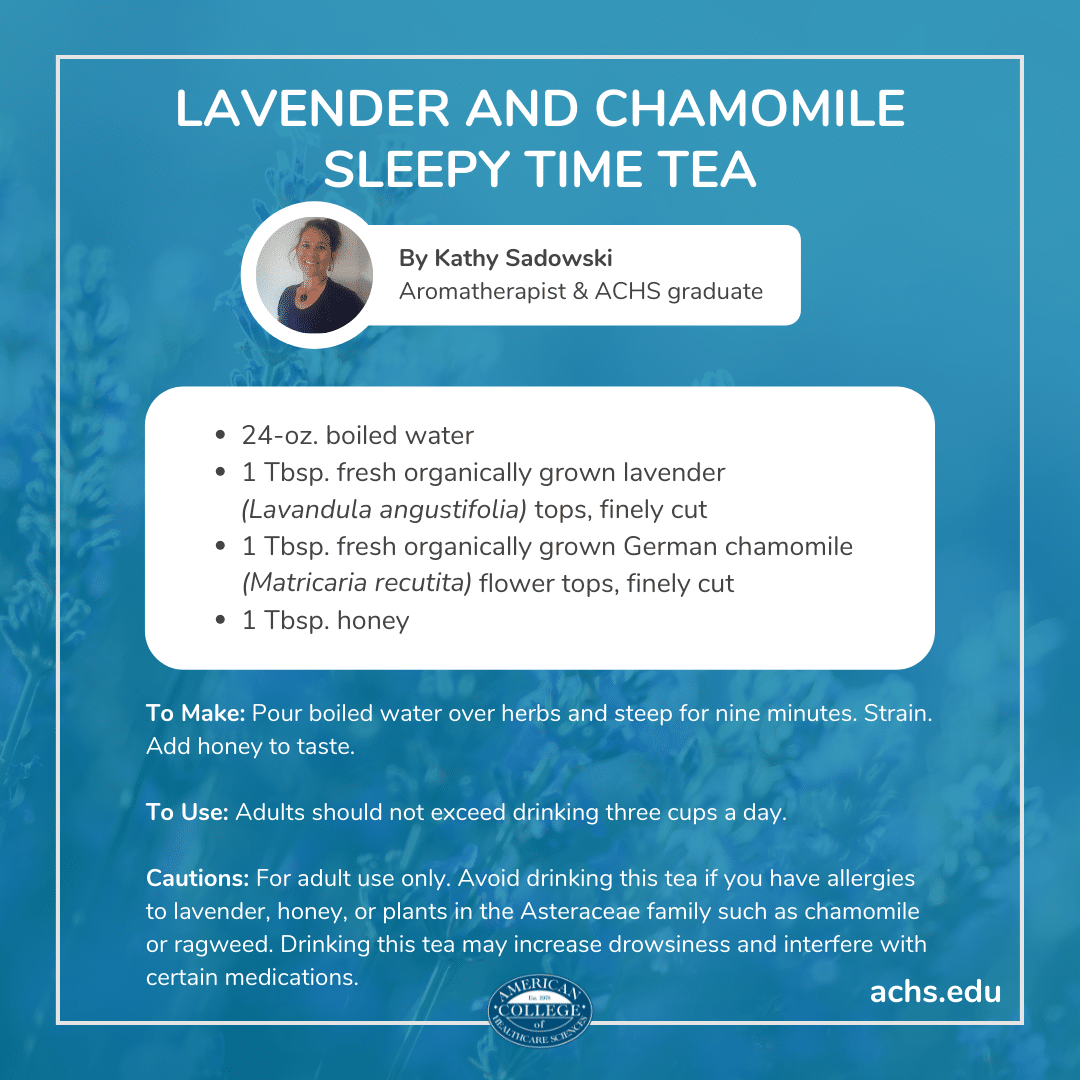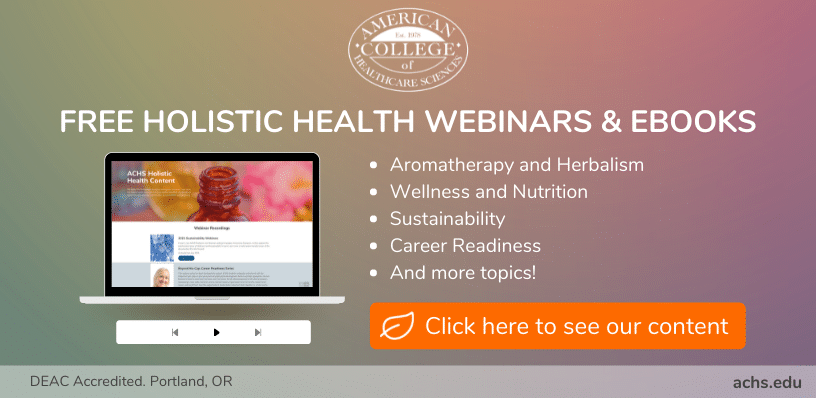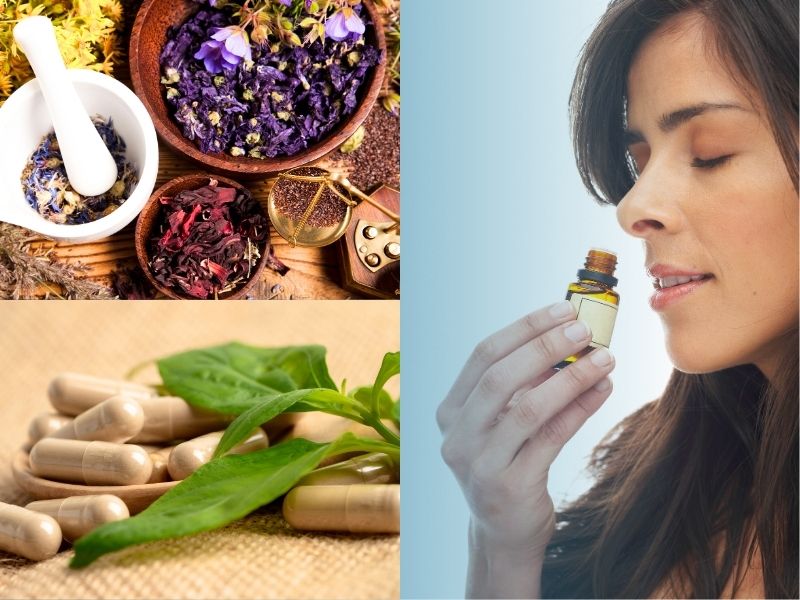By Kathy Sadowski, MS in Aromatherapy, RA, LMT
This article originally appeared in the NAHA Journal (Spring 2021) and it is republished here according to the NAHA Writer Guidelines 2021 copyright statement.
Have you ever gone to the garden store to buy an herb like basil (Ocimum basilicum), to be surprised at how many varieties of the same plant are offered? Maybe you noticed the typical sweet basil, but also a large leaf basil, or even a basil with purple leaves. Like most aromatherapists would be tempted to do, you may have stopped to sniff each of the basil varieties and noticed their differences in aroma.
Several garden herbs offer significant aroma and flavor variations that might be determinable when looking at a plant’s common or botanical name. Sometimes, deeper investigation is required! Whether you are making an herbal tea, flavoring your favorite recipe with fresh-cut herbs, or using an essential oil for aromatherapy, it can be beneficial to know a plant’s chemistry.
This article will discuss what to look for in a plant’s name and some key chemical differences between basil (Ocimum basilicum), Roman chamomile (Chamaemelum nobile), and lavender (Lavandula angustifolia).
Note: Kathy’s full article in the NAHA Journal also covers sweet marjoram (Origanum majorana), mint (Mentha spp.), oregano (Origanum vulgare), sage (Salvia spp.), and thyme (Thymus vulgaris), which we will cover in a second blog post next week.
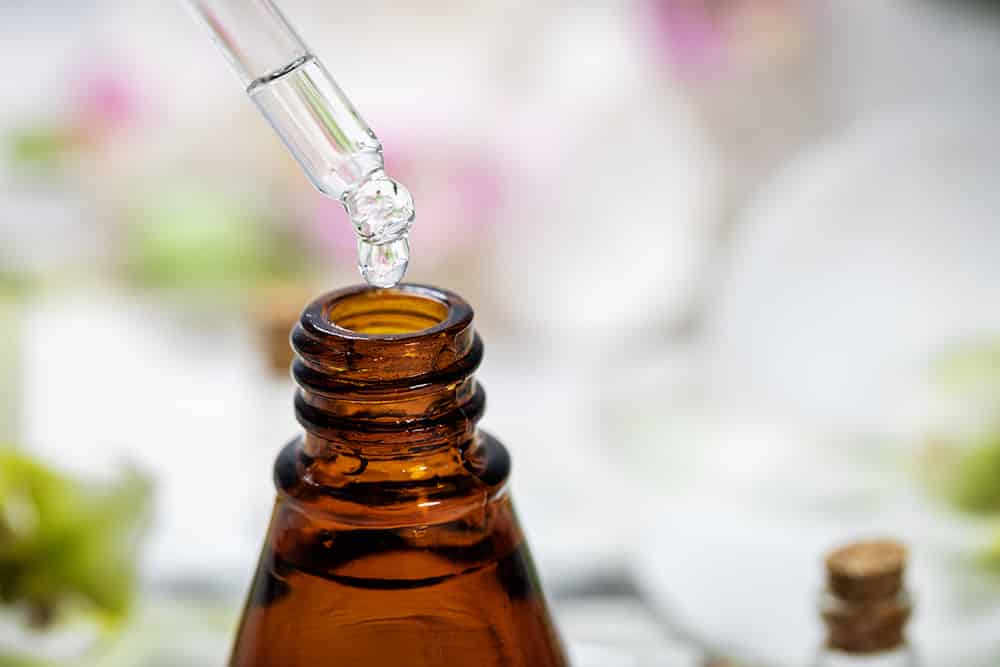
What is a Botanical Name?
Plants are classified based on similar anatomic characteristics. Botanical names identify a plant’s genus, species, and sometimes chemotype, subspecies, or variety. Typically derived from either Latin or Greek words, each plant has a unique botanical name. For example, Roman chamomile has the botanical name of Chamaemelum nobile. The plant’s genus is Chamaemelum and its more specific species is nobile.
Botanical names differ from common names. A plant can have many common names, but typically has one botanical name. Further, botanical names can be used across the world to identify a specific plant, while common names are used locally.
| Subspecies | Variety | Hybrid | |
| Description | A subspecies is a category further specifying species, and typically identifies an established geographically isolated race. | This is a category that further specifies subspecies (when present) or species, based on minor but permanent or heritable characteristics. | Hybrids are created when two different species interbreed. This can be identified in a botanical name with the multiplication symbol × written between the genus and the species. |
| Example | Oregano: Origanum vulgare subsp. Hirtum | Celery: Apium graveolens var. dulce | Lavandin: Lavandula × intermedia.2 This is a cross between L. angustifolia and L. latifolia. |
What is a Chemotype?
When plants from the same species produce differing odor and chemical composition, this is called a chemotype. It is often related to geo-climatic conditions such as temperature, precipitation, soil quality, and elevation. It can also be related to the life-stage of the plant and harvesting time. [1]
Example: Ocimum basilicum ct. linalool. In this example, the dominant chemical component of the plant is linalool.
Eight Aromatic Garden Herbs with Significant Chemical Variations
Basil, chamomile, lavender, sweet marjoram, the mint, oregano, the sage, and the thyme species all have significant chemical variations. This section describes the constituent differences among these plants in more detail. Note that this section identifies some of the variations, but there can be many more! (Also note that marjoram, mint, oregano, sage, and thyme will be covered in a second blog post next week.)
Different Chemotypes of Sweet Basil (Ocimum basilicum) Essential Oil

These are some of the chemo-varieties of basil essential oil as identified by Tisserand & Young (2014): [3]
Ocimum basilicum ct. estragole essential oil contains over 73% of the chemical component estragole.
- Benefits: Some research has shown that estragole has potential anti-inflammatory, antimicrobial, antioxidant, insecticidal, and cholesterol lowering potential. More research is needed. [4]
- Safety: Estragole can be both skin sensitizing and carcinogenic in excess.[5]
Ocimum basilicum ct. linalool essential oil is high in the chemical components of linalool, eugenol, linoleic, and linolenic acids.
- Benefits: Botanicals high in linalool can have an aromatically calming effect.
- Safety: This essential oil may contain 1% estragole, which can be skin sensitizing and carcinogenic in excess.[3],[5]
Ocimum basilicum ct methyl cinnamate essential oil is high in the chemical components of methyl cinnamate and linalool.
- Benefits: With a cinnamon-like aroma and a mild cinnamon flavor, this plant’s scent and taste can be warm and uplifting.
- Safety: This essential oil may contain estragole, which can be skin sensitizing and carcinogenic in excess. [3],[5]
Different Species of Basil Essential Oil
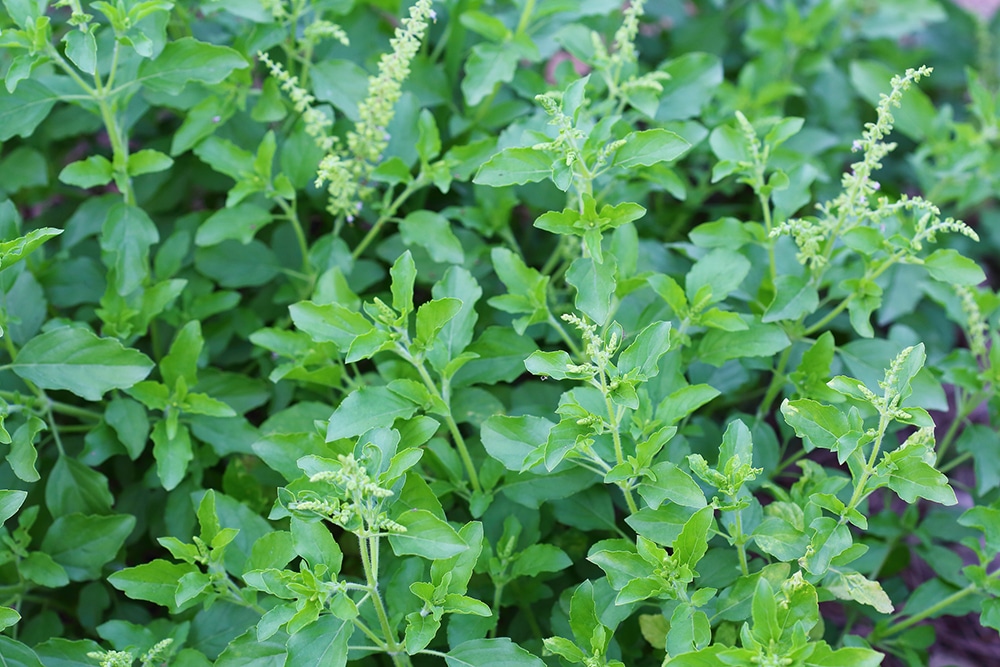
Holy basil (Ocimum sanctum) essential oil is high in the chemical components of eugenol, 1,8-cineole, estragole, and bisabolene.
- Benefits: Eugenol has shown in studies to demonstrate significant antimicrobial activity, with potential anti-inflammatory, cardiac health, and analgesic benefits.[6] The 1,8-cineole content may help with breathing.
- Safety: Potential drug interactions, skin sensitivity, and toxicity in excess.[3]
Lemon basil (Ocimum × citriodorum) essential oil is a hybrid of sweet basil (O. basilicum) and American basil (O. americanum). It has high constituents of geraniol, neral, nerol, linalool, alpha-bisabolene, geraniol, beta-caryophyllene, and menthol.
- Benefits: This basil species has a lemon-floral scent and flavor that is uplifting.
- Safety: Possible drug interactions, toxicity, and skin sensitization of the essential oil.[3]
African basil (Ocimum gratissimum) essential oil is high in the chemical constituents of estragole and camphor.
- Benefits: Some research has shown that estragole has potential anti-inflammatory, antimicrobial, antioxidant, insecticidal, and cholesterol lowering potential. Camphor content may help with respiratory complaints. More research is needed.[4]
- Safety: Estragole can be skin sensitizing and carcinogenic in excess.[5]
Safety note for all basil species: Generally speaking, most basil species contain about 5% essential oil. Avoid ingesting basil beyond normal food quantities during pregnancy, lactation, with small children, or for prolonged periods of time.[7]
Different Types of Chamomile Essential Oil
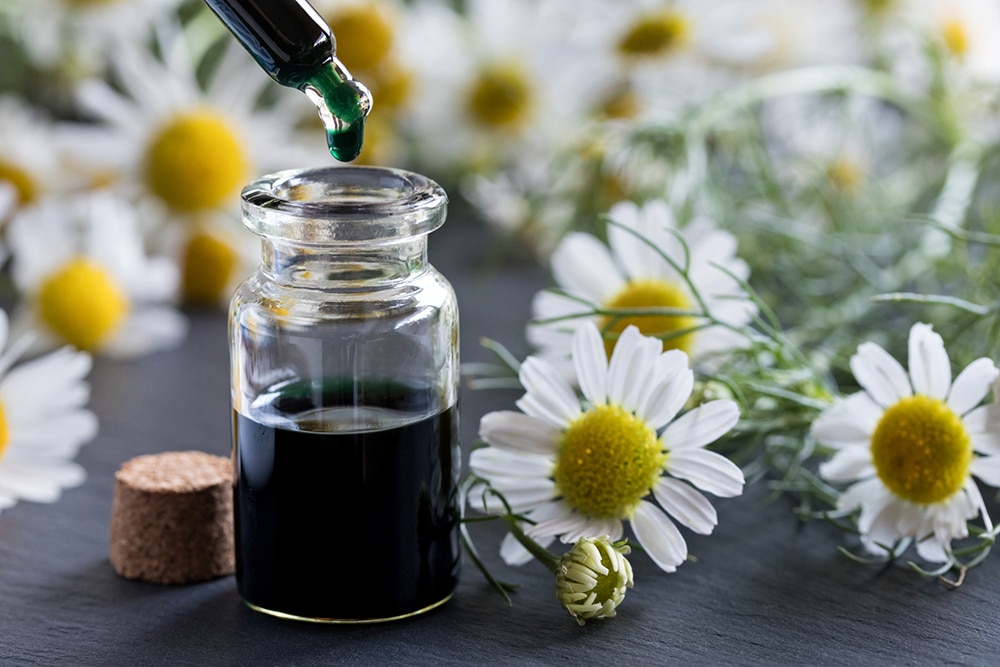
Three types of chamomile species are commonly enjoyed in aromatherapy: German chamomile (Matricaria recutita), Roman chamomile (Chamaemelum nobile), and Moroccan chamomile (Ormenis mixta). They all belong to the Asteraceae family, but each have a different genus and differing chemistry.
German chamomile (Matricaria recutita) essential oil is a distinctively blue-colored essential oil, related to its chamazulene content. There are a variety of chemotypes of German chamomile essential oil, all containing high amounts of α-bisabolol oxide, β-farnesene, and chamazulene.[3]
- Benefits: German chamomile tea is famous for helping people get to sleep![8]
- Safety: Use caution if you have allergies to plants in the Asteraceae family, such as ragweed.
Roman chamomile (Chamaemelum nobile) essential oil is made of up to about 80% esters, with key constituents of isobutyl angelate, butyl angelate, 3-methylpentyl angelate, isobutyl butyrate, isoamyl angelate, and small amounts of chamazulene.[2],[3]
- Benefits: High in ester content, Roman chamomile essential oil has benefits for the skin.[8]
- Safety: Use caution if you have allergies to plants in the Asteraceae family, such as ragweed.
Moroccan chamomile (Ormenis mixta) essential oil, mainly used by the perfume industry, has high amounts of the chemical constituents of santolina alcohol and alpha-pinene.[2],[3]
- Benefits: Enjoy this flower aromatically for its sweet fruity scent!
- Safety: Use caution if you have allergies to plants in the Asteraceae family, such as ragweed.
| Herbal Teas · Chamomile: Chamomile flowers contain about 1% essential oil. To make a tea from chamomile, combine two teaspoons of flower tops with 8-oz. of boiled water and steep for nine minutes. Strain before drinking.[7] · Lavender: The lavender plant contains about 1-3% essential oil and is generally safe for use. To make a lavender tea, use 1-2 teaspoonfuls of lavender per 8-oz. of boiled water.[7] · Mint: The leaves of typical mint plants, such as Mentha x piperita, contain 0.5 – 4% essential oil and are generally safe to enjoy in small amounts but avoid use with gallstones. To make a tea, pour boiled water over 2 teaspoons of leaf and steep about 10 minutes. [7] · Thyme: Thyme used as an herb in small quantities is generally safe, with the plant leaves being comprised of 1 – 2.5% essential oil. To make a tea, pour boiled water over a teaspoonful of leaves and steep for ten minutes.[7] |
Lavender and Lavandin Essential Oils
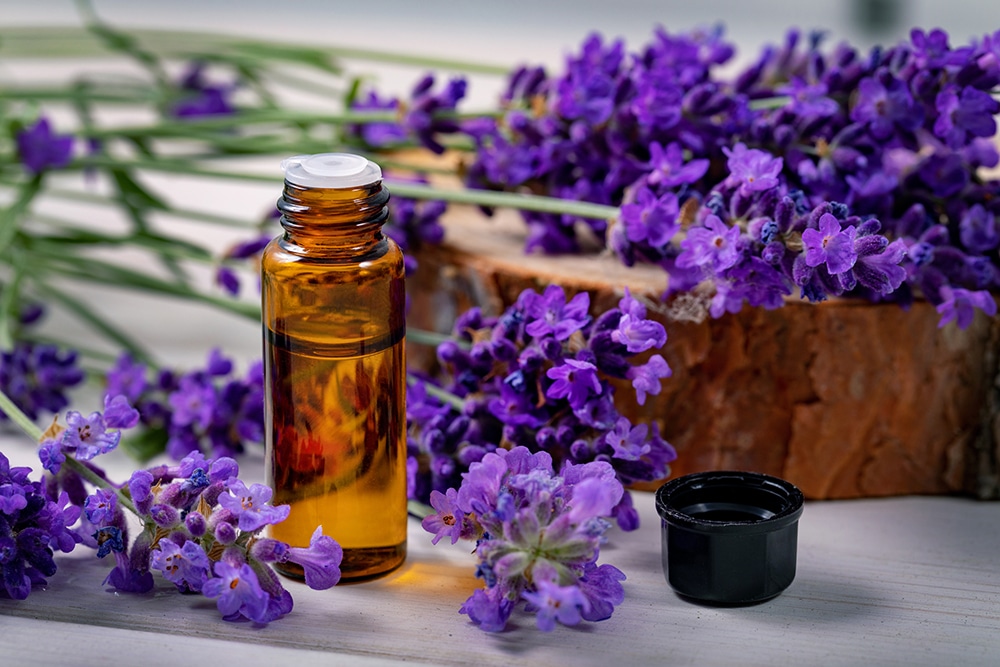
True lavender (Lavandula angustifolia) has a sweet floral and slightly herbaceous aroma, while lavandin (Lavandula × intermedia) is similar in scent with an additional camphor note.4 There are many varieties of lavender seeds that can be purchased for growing, such as Munstead lavender (Lavandula angustifolia var. Munstead), French long (L. angustifolia var. French long), English lavender (L. angustifolia var. English lavender), and hidcote blue lavender (L. angustifolia var. Hidcote blue).
- Lavandin (Lavandula × intermedia) is a hybrid plant producing key constituents of linalool, linalyl acetate, camphor, and 1,8-cineole in the essential oil.[9]
- Lavender (Lavandula angustifolia), known as true lavender, produces an essential oil with 50 – 83 percent linalool and linalyl acetate with chemo-variations based on growing conditions.9
- Spanish lavender (Lavandula stoechas) produces an essential oil which is high in camphor, fenchone, and 1,8-cineole.[3]
- Spike lavender (Lavandula latifolia) essential oil is primarily comprised of linalool, 1,8-cineole, and camphor.[9]
Benefits of Lavandula plants: Those plants which are high in linalool and linalyl acetate constituents can have a calming effect and are good for the skin. Lavender species with camphor and 1,8-cineole components can help with breathing. The plant may also be useful to help ward off biting insects.[10]
Safety: Concerns are related to Lavandula species with constituents of camphor and 1,8-cineole making them less appropriate for use with young children and those with certain medical conditions, such as asthma.
Recipe
Lavender and Chamomile Sleepy Time Tea
Ingredients
- 24-oz. boiled water
- 1 Tbsp. fresh organically grown lavender (Lavandula angustifolia) tops, finely cut
- 1 Tbsp. fresh organically grown German chamomile (Matricaria recutita) flower tops, finely cut
- 1 Tbsp. honey
To Make: Pour boiled water over herbs and steep for nine minutes. Strain. Add honey to taste.
To Use: Adults should not exceed drinking three cups a day.
Cautions: For adult use only. Avoid drinking this tea if you have allergies to lavender, honey, or plants in the Asteraceae family such as chamomile or ragweed. Drinking this tea may increase drowsiness and interfere with certain medications.
References
[1] Bowles, J. (2003). The Chemistry of Aromatherapeutic Oils. 3rd Allen & Unwin.
[2] Buckle, J. (2003). Clinical Aromatherapy Essential Oils in Practice. 2nd Churchill Livingstone.
[3] Tisserand, R. & Young, R. (2014). Essential Oil Safety, 2nd Edition. Churchill Livingstone, Elsevier.
[4] Sadowski, K. (2019). Methyl chavicol / Estragole / p-allyanisole / Isoanethole. Retrieved on 3/3/2021. Retrieved from https://www.earthtokathy.com/methyl-chavicol-estragole-p-allyanisole-isoanethole/
[5] Clarke, S. (2009). Essential Chemistry for Aromatherapy. Elsevier Health Sciences.
[6] Sadowski, K. (2020). Eugenol. Retrieved on 3/3/21. Retrieved from: https://www.earthtokathy.com/eugenol/
[7] Witchl, M. (2004). Herbal Drugs and Phytopharmaceutical: A Handbook for Practice on a Scientific Basis. Third Edition. MedPharm Scientific Publishers.
[8] Sadowski, K. (2019). What is the Difference Between German Chamomile and Roman Chamomile? Retrieved on 3/3/2021. Retrieved from: https://www.uhrohmuh.com/2019/10/31/what-is-the-difference-between-german-chamomile-and-roman-chamomile/
[9] Lis-Balchin, M. (2006). Aromatherapy Science: A Guide for Healthcare Professionals. Pharmaceutical Press.
[10] Sadowski, K. (2020). Lavender (Lavandula angustifolia) Research. Retrieved on 3/3/2021. Retrieved from: https://www.earthtokathy.com/lavender-lavandula-angustifolium-research/
[11] Sadowski, K. (2019). Retrieved on 3/3/2020. Retrieved from: https://www.earthtokathy.com/carvacrol/
[12] Sadowski, K. (2020). Retrieved on 3/3/2020. Retrieved from: https://www.earthtokathy.com/menthol/
[13] Spices Inc. (n.d.). Oregano Throwdown. Mediterranean Oregano vs Mexican Oregano. Retrieved on 3/3/2021. Retrieved from: https://www.spicesinc.com/p-3778-the-oregano-throwdown-mediterranean-vs-mexican.aspx
[14] Ulbricht, C. (2010). Natural Standard. Herb & Supplement Guide: An Evidence Based Reference.
[15] Elpel, T. (2018). Botany in a Day: The Patterns Method of Plant Identification. An Herbal Field Guide to Plant Families of North America. US: Hops Press.
About Kathy Sadoswki:
Kathy Sadowski has a Master of Science degree in Aromatherapy from the American College of Healthcare Sciences. With a passion for reading scientific studies on herbs and essential oils, she has developed the website www.EarthtoKathy.com, which categorizes 4,000 plus scientific research articles on plants by species, therapeutic action, and constituent. The goal is to demonstrate a growing amount of evidence for the potential healthful uses of herbs and essential oils. Kathy is a professional member of NAHA and AIA, a Registered Aromatherapist (ARC), licensed massage therapist, and enthusiast for environmental protection and a natural lifestyle. Visit Kathy’s website at: www.EarthtoKathy.com
Disclaimer: This article is for informational purposes only. It is not intended to treat, diagnose, cure, or prevent disease. This article has not been reviewed by the FDA. Always consult with your primary care physician or naturopathic doctor before making any significant changes to your health and wellness routine.
About American College of Healthcare Sciences

This commitment to our students and graduates reflects in our current survey results that reflect 98% of our students would recommend ACHS to a friend or family member.
We believe education is the most powerful tool for changing an individual and the world around us.
When a person enrolls as ACHS, it is vitally important that they graduate with tools they need to forge their own holistic and sustainable missions, build up their communities confidently and changing the face of healthcare with knowledge.
